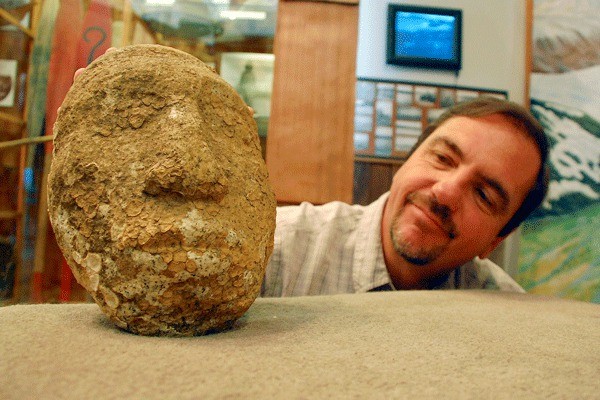Is it 20 years old or a thousand? Was it carved by Native Americans or white settlers? Perhaps it was made more recently by a local artisan?
These are all good questions but, so far, the origins and history of a stone face found submerged in Perego’s Lagoon on the west side of Whidbey Island 15 years ago has local, state and tribal experts all scratching their heads.
In fact, the only positive conclusion reached so far about the curious piece is what to name it.
“We call him Perego Man,” said a smiling Rick Castellano, executive director of the Island County Historical Society in Coupeville.
The mysterious face, which was carved into what appears to be one of the head-sized granite boulders that litter Whidbey beaches, was found in 1997 by a family visiting from Seattle.
The boy, whom Castellano could only identify as Anand, was wading through the lagoon at the foot of Ebey’s Bluff when he stepped on something sharp. Looking down, he discovered the barnacle covered face.
“It was looking back at him,” Castellano said.
As the story goes, the family took the object home but brought it back soon after experiencing a string of bad luck. According to Castellano, the boy’s mother was intent on tossing it back in the lagoon but was persuaded otherwise by a friend, former Coupeville resident John Pawley.
He remained in stewardship of the face for many years but Pawley decided to donate the piece to the museum this past June before moving to Oregon. Castellano said he’s always happy to increase the historical society’s collection but this piece has been particularly challenging to identify.
“We can usually figure out where something came from … but this one is a mystery,” Castellano said.
“It’s a very odd, weird and unusual piece,” he said.
Pictures were sent to experts at the Burke Museum of Natural History and Culture at the University of Washington in the hopes of shedding some light on the carving but they also had few answers, according to Castellano. While they thought the piece was interesting, they could not classify or identify it with any particular culture or time period, he said.
Theresa Trebon, tribal archivist for the Swinomish Indian Tribal Community, has also examined the piece but doesn’t believe it’s from any Northwest tribes or is Native American at all.
She did some work for Ebey’s Landing National Historic Reserve years ago and actually examined the same carving in 1998 for Pawley. She has examined thousands of other Whidbey artifacts as well and nothing looked even remotely like it, she said.
“There is a real distinctive Native American signature and I just don’t see it on this,” she said.
Trebon does have a theory, however. She said she recently visited Hawaii and thinks the face better represents the stone-carving styles of Polynesians.
The theory is not as far fetched as it sounds. Native Hawaiians and other Pacific Islanders, sometimes referred to in history as “Kanakas,” were often employed on merchant and whaling ships in the 1800s.
They had such a presence in the Northwest that their heritage is still evident today, hence the cities of Kalama and Friday Harbor, both of which are named after Native Hawaiian men.
Given that Port Townsend was an international port, it’s entirely possible the stone was carved by a long ago sailor and then tossed or lost in the lagoon.
Castellano said the jury is still out and hopes additional research will yield more answers about the carving’s mysterious past. However, he said there is small part of him that hopes to never find out just where it came from.
“It’s one of those things; do I really want to have the answer?” he said. “It would take all the romance out of it.”




